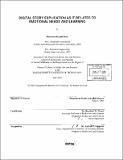| dc.contributor.advisor | Rosalind W. Picard. | en_US |
| dc.contributor.author | Daily, Shaundra Bryant | en_US |
| dc.contributor.other | Massachusetts Institute of Technology. Dept. of Architecture. Program In Media Arts and Sciences | en_US |
| dc.date.accessioned | 2006-03-29T18:50:34Z | |
| dc.date.available | 2006-03-29T18:50:34Z | |
| dc.date.copyright | 2005 | en_US |
| dc.date.issued | 2005 | en_US |
| dc.identifier.uri | http://hdl.handle.net/1721.1/32503 | |
| dc.description | Thesis (S.M.)--Massachusetts Institute of Technology, School of Architecture and Planning, Program in Media Arts and Sciences, 2005. | en_US |
| dc.description | Includes bibliographical references (leaves 78-81). | en_US |
| dc.description.abstract | Too often, efforts toward re-thinking learning environments focus solely on the cognitive aspects of education. By expanding our view to consider other aspects of adolescent development involved in education, we can begin to address the needs of the whole child. This research aims to 1) gain a better understanding of the effects of immediate emotions in middle school academic contexts and 2) create a system geared toward addressing the emotional needs of teenage girls. To support emotional self-awareness and empathy, a proactive emotional health was developed. This is a part of a long-term research plan for understanding the role that digital technology can play in helping address emotions and support learning for teenage girls. The system, G.I.R.L.S (Girls Involved in Real Life Sharing) Talk, allows users to reflect actively upon the emotions related to their situations through the construction of pictorial narratives. Users of this new system were able to gain new knowledge and understanding about themselves and others through the exploration of authentic and personal experiences. The system employs a new technology called common sense reasoning that enables it to infer affective content from the users' stories and support emotional reflection. This system has been evaluated with seventeen subjects; one group used the G.I.R.L.S. Talk system with emotional reflection support, while the control group used the system without the support. Over three weeks, the group supported with common sense reasoning about emotion increased the variety of emotion words used in their writing; the control group showed no such increase. | en_US |
| dc.description.abstract | (cont.) In both cases, the system enabled the subjects to express themselves freely in a comfortable and meaningful way. Overall, this thesis makes three main contributions: 1) new insights into the effects of immediate emotions in academic situations for adolescents, 2) a new system for supporting teenage girls' emotional self-awareness and empathy, and 3) new insight into the value of utilizing constructionist technologies in proactive emotional health systems. | en_US |
| dc.description.statementofresponsibility | by Shaundra Bryant Daily. | en_US |
| dc.format.extent | 112 leaves | en_US |
| dc.format.extent | 5858254 bytes | |
| dc.format.extent | 5864740 bytes | |
| dc.format.mimetype | application/pdf | |
| dc.format.mimetype | application/pdf | |
| dc.language.iso | eng | en_US |
| dc.publisher | Massachusetts Institute of Technology | en_US |
| dc.rights | M.I.T. theses are protected by copyright. They may be viewed from this source for any purpose, but reproduction or distribution in any format is prohibited without written permission. See provided URL for inquiries about permission. | en_US |
| dc.rights.uri | http://dspace.mit.edu/handle/1721.1/7582 | |
| dc.subject | Architecture. Program In Media Arts and Sciences | en_US |
| dc.title | Digital story explication as it relates to emotional needs and learning | en_US |
| dc.type | Thesis | en_US |
| dc.description.degree | S.M. | en_US |
| dc.contributor.department | Program in Media Arts and Sciences (Massachusetts Institute of Technology) | |
| dc.identifier.oclc | 61900601 | en_US |
